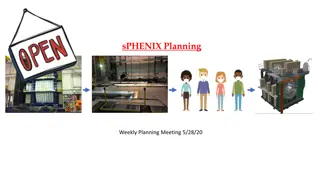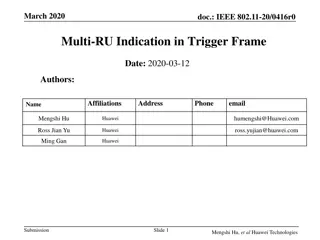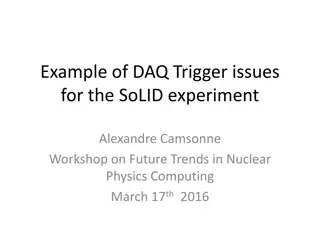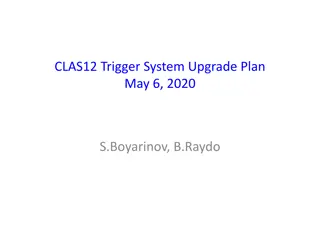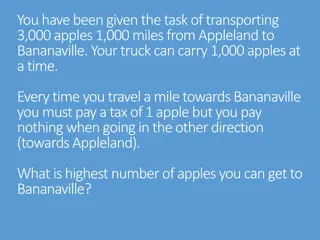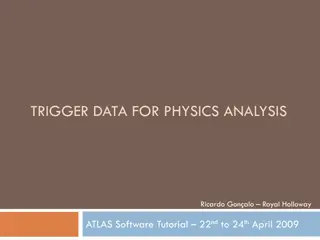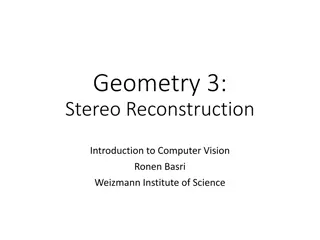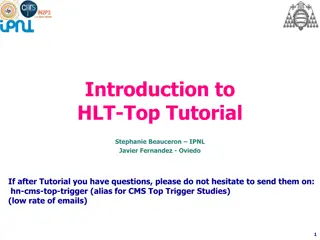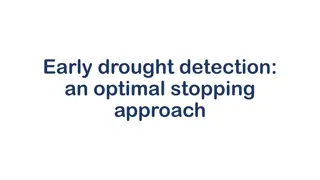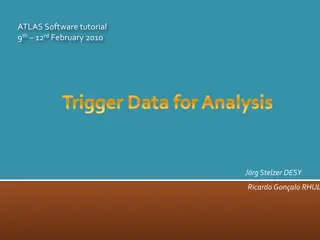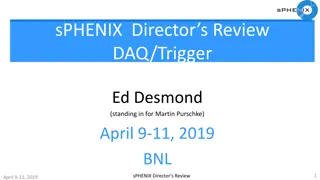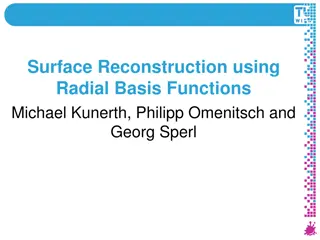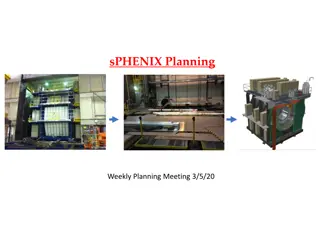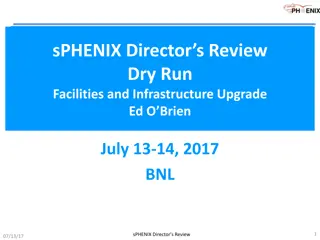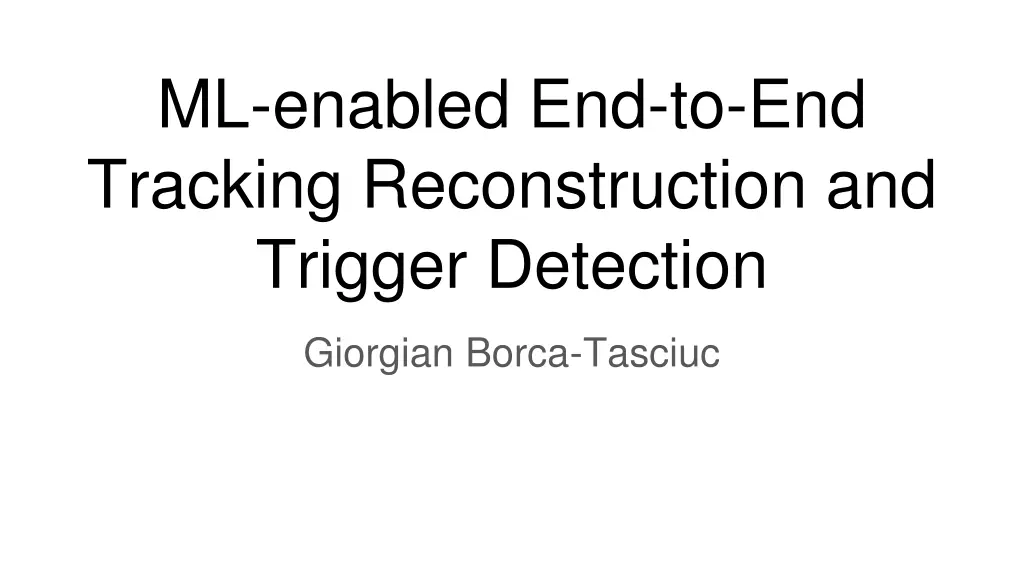
Advanced ML-Enabled End-to-End Tracking and Reconstruction Insights
Explore the innovative ML-enabled end-to-end tracking reconstruction techniques by Giorgian Borca-Tasciuc. Dive into problem overviews, pixel hits, clustering methods, hits tracks, and neural network architecture in this cutting-edge study. Gain insights into edge candidate selection and overall problem definition for enhanced understanding.
Download Presentation

Please find below an Image/Link to download the presentation.
The content on the website is provided AS IS for your information and personal use only. It may not be sold, licensed, or shared on other websites without obtaining consent from the author. If you encounter any issues during the download, it is possible that the publisher has removed the file from their server.
You are allowed to download the files provided on this website for personal or commercial use, subject to the condition that they are used lawfully. All files are the property of their respective owners.
The content on the website is provided AS IS for your information and personal use only. It may not be sold, licensed, or shared on other websites without obtaining consent from the author.
E N D
Presentation Transcript
ML-enabled End-to-End Tracking Reconstruction and Trigger Detection Giorgian Borca-Tasciuc
Overview 1. Problem Overview 2. Pixels Hits 3. Hits Tracks 4. Tracks Label 5. Remaining Challenges 6. Conclusion
Clustering Clustering is done by solving a spanning forest problem There is an edge between pixels that are adjacent to each other Mean of all pixels in a cluster is taken as the hit location Most time-consuming portion, we are developing a sparse CNN to perform faster clustering
Problem Definition Once we have hits, we want to group hits that came from the same particle into a track This will be solved by treating the problem as an edge classification problem Out of the N2possible edges between the hits, we want to know the true edges.
Edge Candidate Selection Not all of the N2possible edges are plausible - we can eliminate a lot of edges from the get-go We can use some basic geometric constraints on the cylindrical coordinates of the hits | / r| <= PHI_SLOPE_MAX |z0| <= Z_ORIGIN_MAX z0= z1- r ( z/ r) The geometric constraints determine much of the latency and will play a vital role in further reducing the FPGA latency.
Neural Network Architecture Message passing architecture. Initialization: hv(0)= xv v V xv= (r/3, , z/3, npixels in hit, layer) Message Creation: mu,v(t)= fMessage(hu(t-1), hv(t-1)) Message Aggregation: av(t)= (fAgg({mu,v(t): v N(u)}), fAgg({mv,u(t): v N-1(u)})) Node Update: hv(t)= fUpdate(hv(t-1), av(t))
Message Network Details (This slide is very busy) mu,v(t)= fMessage(hu(t-1), hv(t-1)) av(t)= (fAgg({mu,v(t): v N(u)}), fAgg({mv,u(t): v N-1(u)})) fEdge: ( f f) [0, 1] fEdge(hu, hv) = MLP(hu, hv) fMessage: ( f f) 2f fMessage(hu, hv) = fEdge(hu, hv) hu fAgg(M) = mm
Node Network Details hv(t)= fUpdate(hv(t-1), av(t)) fUpdate: ( f 2f) f fUpdate(hu, au) = MLP(hu, au) + hu
Track Construction Once edge classification is performed, a track is constructed by finding the connected components Track is constructed by finding the mean of the hits on each layer
Performance Metric Year Value Accuracy 2023 92.07% Precision 2023 92.54% Recall 2023 97.97% F1 2023 95.18% Accuracy 2022 96.30% Precision 2022 84.55% Recall 2022 83.25% F1 2022 83.89%
Problem Definition After creating the tracks, we have a set of tracks We want to know whether the event that created these tracks was a trigger event A trigger event is an event in which we had a D0 ( +, -) or D0 ( -, +) decay
What needs to be modeled? D0 ( +, -) or D0 ( -, +) Considering the problem from a high level perspective, we need to consider: Track-to-track Interactions: Do these pair of tracks form a ( +, -) or ( +, -) pair? Track-to-global Interactions: Where is the origin of this track? Global-to-Track Interactions: Incorporate information about the origin of this track into the track embeddings
Architecture Previous considerations motivate the following block. Set Encoder: Track-to-Track interactions Bipartite Aggregation: Track-to-Global and Global-to-Track interactions
Set Encoder Create Query, Key, Value embeddings from track embeddings using an MLP Find attention between every track i and track j by calculating Qi Kjand using the softmax to normalize the sum of attention scores to 1 Weigh value embeddings by the attention score and aggregate to create new track embeddings
Bipartite Aggregators Use an MLP: f n, followed by a softmax to determine how much each track contributes to each aggregator f is size of track embedding n is number of aggregators For each aggregator: Scale each track by its contribution score to that aggregator Perform max and mean pooling over scaled tracks to calculate aggregator embedding Concatenate aggregators to track embeddings, and use an MLP to update track embeddings
Architecture Stack multiple SEBA Blocks Use Bipartite Aggregation with single aggregator to generate event embedding MLP on event embedding to predict Trigger Event
Track Features Track given to trigger classifier has the following features: (x, y, z) location of hit on each layer Length segment between each layer Angle formed by segments Estimated radius of circle fit to hits Estimated center of circle fit to hits Estimated transverse momentum of track Estimated radius and center provided ~10pp increase in performance
Multi-Task Learning to Improve model performance Several modifications to standard training process in order to improve the performance and robustness of our trigger algorithm Track embeddings used predict whether two tracks come from the same parent We perturb hits off the detector layers while keeping it on the particle path = LCE(triggerpred, triggertrue) + LCE(Apred, Atrue)
Performance Data Year Metric Result GT Tracks 2023 Accuracy 90.22% GT Tracks 2023 Precision 86.35% GT Tracks 2023 Recall 95.41% Predicted Tracks 2022 Accuracy 84.01% GT Tracks 2022 Accuracy 87.5%
Remaining Challenges Modifying algorithms to deal with pile-up Work on simplifying algorithms and reducing data quantity to meet latency challenges Initial study of latency-accuracy tradeoff showed we could reduce edge quantity at the tracking stage by 60% with minimal loss in final trigger accuracy Ensure trigger algorithm works in explainable and robust way Initial study has shown model prefers to drop non-trigger tracks without affecting event label and prefers to perturb hits as to not affect the track radius
Conclusion ML models have shown steady increases in performance on the triggering problem Incorporating physics knowledge been responsible for large gains in performance in trigger prediction Challenges remain in adapting the ML algorithm to the real-world latency and data availability constraints

